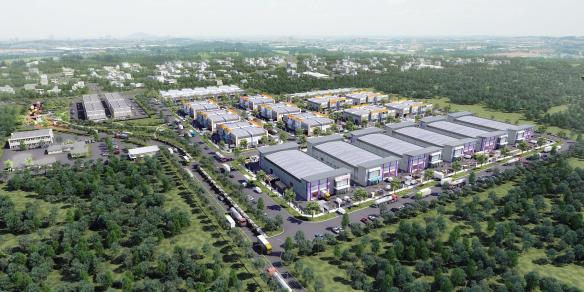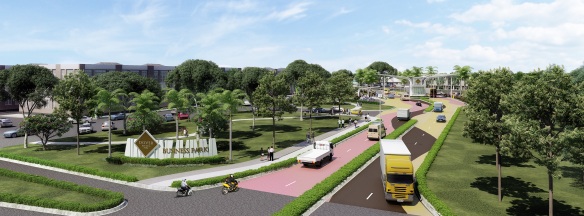
Aerial view of Senibong Cove with the Straits of Johor and Sembawang Shipyard at the backdrop. Photo: Khalil Adis Consultancy.
There are many opportunities to be sought in Iskandar Malaysia in 2016. We list our top 10 here.
By Khalil Adis

Aerial view of Iskandar Puteri. Photo: Khalil Adis Consultancy
Reason 1: Iskandar Malaysia is the top performing economic corridor in Malaysia.
Due to its close proximity to Singapore, Iskandar Malaysia is the most successful out of the five economic corridors in Malaysia. Latest figures from Iskandar Regional Development Authority (IRDA) showed that Singapore is the top foreign investor followed by China, the United States of America, Spain and Japan. The total cumulative investment from 2006 to October 2015 is now RM78.53 billion with the manufacturing sector leading the way at RM50.82 billion.

Murals on shophouses at the heritage area of Johor Bahru old town. Photo: Khalil Adis Consultancy.
Reason 2: Tourism boost
With Singapore being an international hub and the closest to the Malaysian state of Johor, government officials are setting its sight to get more Singaporeans and international travellers to cross the border.
Figures from Johor Immigration Department showed that Singaporeans were the top visitors to the state in 2011 and 2012 with 13,448,062 and 17.192.742 visitor arrivals respectively. This was an increase of 27.8 per cent. Meanwhile, according to figures from the Singapore Tourism Board (STB), the Lion City recorded 1.72 million tourist arrivals from China and 940,000 from India in 2014. In the same year, 620,000 and 290,000 Chinese and Indian tourists respectively visited Johor.
With many using Singapore as a transit point, the aim for 2016 is to attract around five million tourists from China, India, Indonesia and the Middle East. Excluding visitors from Singapore, the figures could hit beyond the five million mark.
With so many things to look forward to by the end of this year, like taking a stroll along Sungei Segget and exploring the many rich cultural gems that Johor Bahru has to offer, 2016 could well be a busy year for the tourism industry and its related sector like retail and food & beverage.

View of causeway from Woodlands to Johor Bahru. Photo: Khalil Adis Consultancy.
Reason 3: Enhanced connectivity to Singapore
Bukit Chagar in Johor Bahru and Woodlands North in Singapore are set to be the next property hotspots once the planned cross-border rail service linking Johor’s Rapid Transit System (RTS) and Singapore’s MRT system is completed in 2018 to 2019.
First announced by Singapore Prime Minister Lee Hsien Loong and Malaysian Prime Minister Dato’ Sri Najib Tun Abdul Razak at the Leader’s Retreat in May 2010, the cross-border rail service will enhance cross-border travel and bring about a positive impact on property prices on both sides of the causeway.
Already, the project is making good progress with a joint feasibility study completed. Bukit Chagar has been announced as the final site.

A dedicated bus lane will serve the BRT lines in Iskandar Malaysia. Photo: Khalil Adis Consultancy.
Reason 4: BRT Lines
In addition, the Bus Rapid Transit (BRT) lines are expected to commence their services soon with the interchange station at Bukit Chagar. It will feature a dedicated bus lane with three lines. Therefore, this will increase the desirability for properties that are located along the lines. BRT Line 1 will span from Bukit Chagar to Tebrau, BRT Line 2 from Bukit Chagar to Senai and finally, BRT Line 3 from Bukit Chagar to Nusajaya.

Monorail in Bukit Bintang. The entire train system will be connected to the High Speed Rail Station in Bandar Malaysia. Photo credit: Khalil Adis Consultancy.
Reason 5: High Speed Rail Project
The Johor stop for the High Speed Rail project will be in the vicinity of Gerbang Nusajaya, not to far away from East Ledang and Motorsports City. This will be the final leg of the Malaysian station before it enters Singapore, terminating at Jurong East. While the station in Nusajaya has not yet been announced, government officials have indicated that it will be located close to Motorsports City near East Ledang.

Towering office buildings in KLCC. Photo credit: Khalil Adis Consultancy.
Reason 6: A new CBD in Gerbang Nusajaya
In April 2015, Nusajaya’s master developer UEM Sunrise Berhad further revealed its comprehensive development plans for Gerbang Nusajaya which will have its own CBD similar to Jurong Lake District.
Spread across 4,551 acres of land, this second phase of Nusajaya’s development will be designed with catalytic industries similar to the various economic drivers in Nusajaya and Medini.Both these areas are home to tourism, logistics, finance, information communication technology and creative industry establishments just to name a few.
In anticipation for the HSR terminus in Gerbang Nusajaya, a number of catalytic developments have been planned. They include Nusajaya Tech Park, a 519-acre integrated eco-friendly tech park and FASTrack Iskandar which is a 300-acre ‘motorsports city’. This is the closest hint we can get on the possibility of the Nusajaya HSR station being located here. With a gross development value of RM42 billion,property values for existing homes in Nusajaya and Medini will enjoy a boost from the economic spillover.

RM18 billion boost for the Pengerang RAPID Project. Photo credit: Khalil Adis Consultancy.
Reason 7: RM18 billion boost for Pengerang RAPID project
Outlined as one of the key areas under Malaysia’s Economic Transformation Plan (ETP), the Pengerang RAPID project aims to raise the quality of life, create jobs and income levels in eastern Johor.
Launched in 2013 with an initial investment of US$20 billion, this massive oil and gas project has already created jobs for some 50, 000 construction workers and 400 engineers. So far, the first phase, which comprises a RM9 billion Pengerang Independent Deep Water Petroleum Terminal, has already been completed in 2014. The first phase of its petroleum storage facility will have the capacity to store up to 1.3 million cubic metres of petroleum products. By end 2016, a further 4, 000 jobs will be created for trained technical staff once the project comes progressively on-stream.
Once the refinery is completed, the Pengerang RAPID project will have the capacity to produce 300, 000 barrels per day of higher grade fuels meeting European specifications and other byproducts for the different industries. RM18 billion has been allocated here as part of Budget 2016.

A lonely stretch of road in Desaru. Photo credit: Khalil Adis Consultancy.
Reason 8: The Eastern Gate is the next growth centre
Deemed as an ‘ulu’ area, homes in Pasir Gudang are currently averaging between RM300 to RM400 per sq ft. However, this is an up and coming area as the Eastern Gate is the only zone that has received budget allocation from Budget 2016.
The Pengerang RAPID project is expected to have a spillover impact in Pasir Gudang. In addition, the budget had also allocated for a new public hospital in Pasir Gudang to cater to its growing population. With this, the Eastern Gate is poised to be the next growth centre in Iskandar Malaysia. If we study the history of Nusajaya and Johor Bahru, homes in these areas have seen almost 50 per cent increase in their values. History could repeat itself in the Eastern Gate.
The state and federal government had allocated spending for public infrastructure. These include the upgrading of the Pasir Gudang Highway and a new hospital.

Petronas Twin Towers in KLCC. More jobs are expected to be created in Pengerang. Photo credit: Khalil Adis Consultancy.
Reason 9: More jobs to be created
With phase one of Iskandar Malaysia successfully launched in Nusajaya in 2006 and phase two currently taking place in Johor Bahru, the Eastern Gate is what many perceive as phase three of Iskandar Malaysia’s economic development.
With the Pengerang RAPID projects and a new business park in Pasir Gudang as the major economic drivers, these are expected to create job opportunities for Johoreans.
The business park for instance is anticipated to create around 12,100 jobs in the sectors of food and beverage production, garment manufacturer, printing and packaging industries, electronics, storage and warehousing, services, information technology, machinery spare parts, carpentry and furniture production and automotive workshops
Meanwhile, the Pengerang RAPID RM70 billion project spanning 2,000 hectares, has already created 40,000 jobs in the construction industry, 400 jobs for engineers and a further 4,000 jobs for trained technical staff. With the further allocation of RM18 billion, more jobs will be created.

Hershey’s is the leading North American manufacturer of quality chocolate and non-chocolate confectionery and chocolate-related grocery products. The company also is a leader in the gum and mint category. Photo credit: The Hershey’s Company.
Reason 10: Senai and the chocolate factory
Senai and Skudai comprises agricultural, industrial and pockets of residential and commercial areas. There are two small towns located here – Senai and Skudai.. Over the years, Senai and Skudai has developed as a hub for food & agro processing and retail tourism. In 2013, it scored a major coup when Hershey’s opened its chocolate factory here just opposite Senai Hi Tech Park.
With an investment of RM816 million, this will be Hershey’s second largest plant in the world and is expected to create 400 jobs Johoreans. It will have the capacity to produce tens of millions of Hershey’s Kisses, Reese’s Peanut Butter Cups and Hershey’s Bars every day.

























